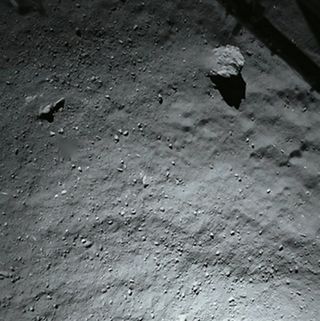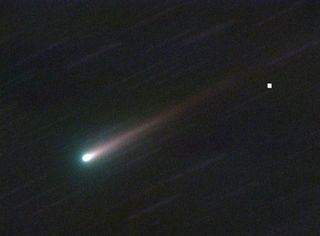Philae Spacecraft to Drill into Comet As Battery Life Dwindles

Europe's Philae lander is expected to drill into the surface of its comet for the first time as the probe might be running out of battery life, European Space Agency officials said today (Nov. 14).
The Philae lander deployed its drill down to the surface to start taking samples of Comet 67P/Churyumov-Gerasimenko today. Officials are hoping that the drill reached the comet's surface, and that data collected during the experiment will be sent back to Earth before the probe's battery dies.
Philae's drill instrument is designed to help scientists understand exactly what the icy world is made of, to potentially unlock secrets of the solar system's past. Philae's landing marks the first time humans have ever soft-landed a probe on the face of a comet. [Rosetta Comet Landing: Complete Coverage]

"This is unique and will be unique forever," Andrea Accomazzo, ESA Rosetta flight director, said of the historic landing in a webcast today. "Let's not forget this."
The drill's first samples will be used in the COSAC (short for Cometary Sampling and Composition Experiment) instrument, Philippe Gaudon, Centre National d'Etudes Spatiales Rosetta project manager, said during the webcast. That Philae experiment "detects and identifies complex organic molecules," like water and carbon compounds, which could have bearing on how the solar system was seeded with water, according to ESA.
Scientists are worried, however, that the drill didn't reach the surface of the comet. In its current position, the drill might be out of reach of the ground, according to ESA officials.
"The drill has to make quite a distance," Valentina Lommatsch, of the DLR-Lander Control Center mission team, said during the webcast. "We'll have to hope that it reaches the ground. It's hard to say."
Get the Space.com Newsletter
Breaking space news, the latest updates on rocket launches, skywatching events and more!
Officials were initially concerned that using the drill instrument would be risky. Philae bounced twice before coming to its current landing spot after its initial touchdown on Comet 67P/C-G after it was released from the Rosetta orbiter on Nov. 12.
The lander never deployed its harpoon system used to keep it tethered in place on the surface, so mission controllers were initially concerned that the force of the drill might move Philae into a more precarious position. But they went ahead with the experiment anyway.
ESA officials are also concerned that the lander is running out of time to conduct science. Philae's initial landing spot would have given its solar cells 6 to 7 hours of sunlight per day, but now, the lander is in the shadow of a cliff and only receives about 1.5 hours of sunlight.
The lander is probably in the process of using up the last of its stored battery life, officials said. Mission controllers are currently out of contact with Philae due to the comet's orbit, but they are hoping to regain a connection later tonight, when more science data should be beamed back to Earth.
"We are hoping to get contact again this evening," said Stephan Ulamec, Philae lander manager at the DLR German Aerospace Center. "This would be fantastic, but it's not secured. So maybe the battery will be empty before we get contact again."
Even if Philae totally depletes its battery life, it is still possible that if Rosetta lines up with Philae as sunlight hits the probe's solar panel, it could beam back more data to Earth again at some point in the mission, Lommatsch noted.
Mission operators still aren't exactly sure where Philae is in relation to its first landing site. Officials think the lander bounced about 0.6 miles (1 kilometer) into space before coming back down for its second landing. It then hopped a short distance in the comet's low gravity to come to rest where it is positioned now. Scientists still aren't exactly sure of its orientation, and officials are using the Rosetta orbiter's imaging system to hunt for the lander.

Follow Miriam Kramer @mirikramer. Follow us @Spacedotcom, Facebook and Google+. Original article on Space.com.
Join our Space Forums to keep talking space on the latest missions, night sky and more! And if you have a news tip, correction or comment, let us know at: community@space.com.

Miriam Kramer joined Space.com as a Staff Writer in December 2012. Since then, she has floated in weightlessness on a zero-gravity flight, felt the pull of 4-Gs in a trainer aircraft and watched rockets soar into space from Florida and Virginia. She also served as Space.com's lead space entertainment reporter, and enjoys all aspects of space news, astronomy and commercial spaceflight. Miriam has also presented space stories during live interviews with Fox News and other TV and radio outlets. She originally hails from Knoxville, Tennessee where she and her family would take trips to dark spots on the outskirts of town to watch meteor showers every year. She loves to travel and one day hopes to see the northern lights in person. Miriam is currently a space reporter with Axios, writing the Axios Space newsletter. You can follow Miriam on Twitter.
